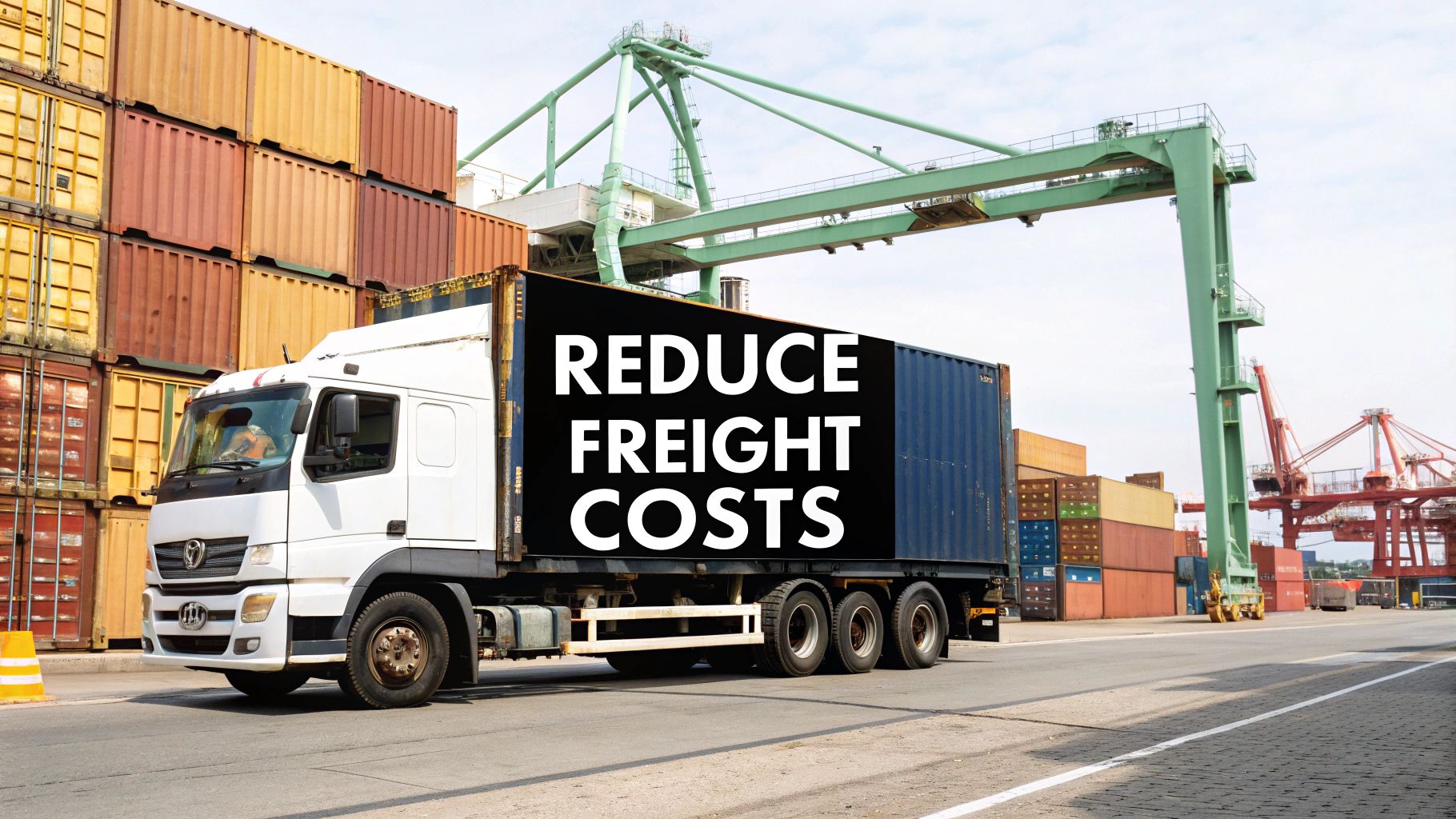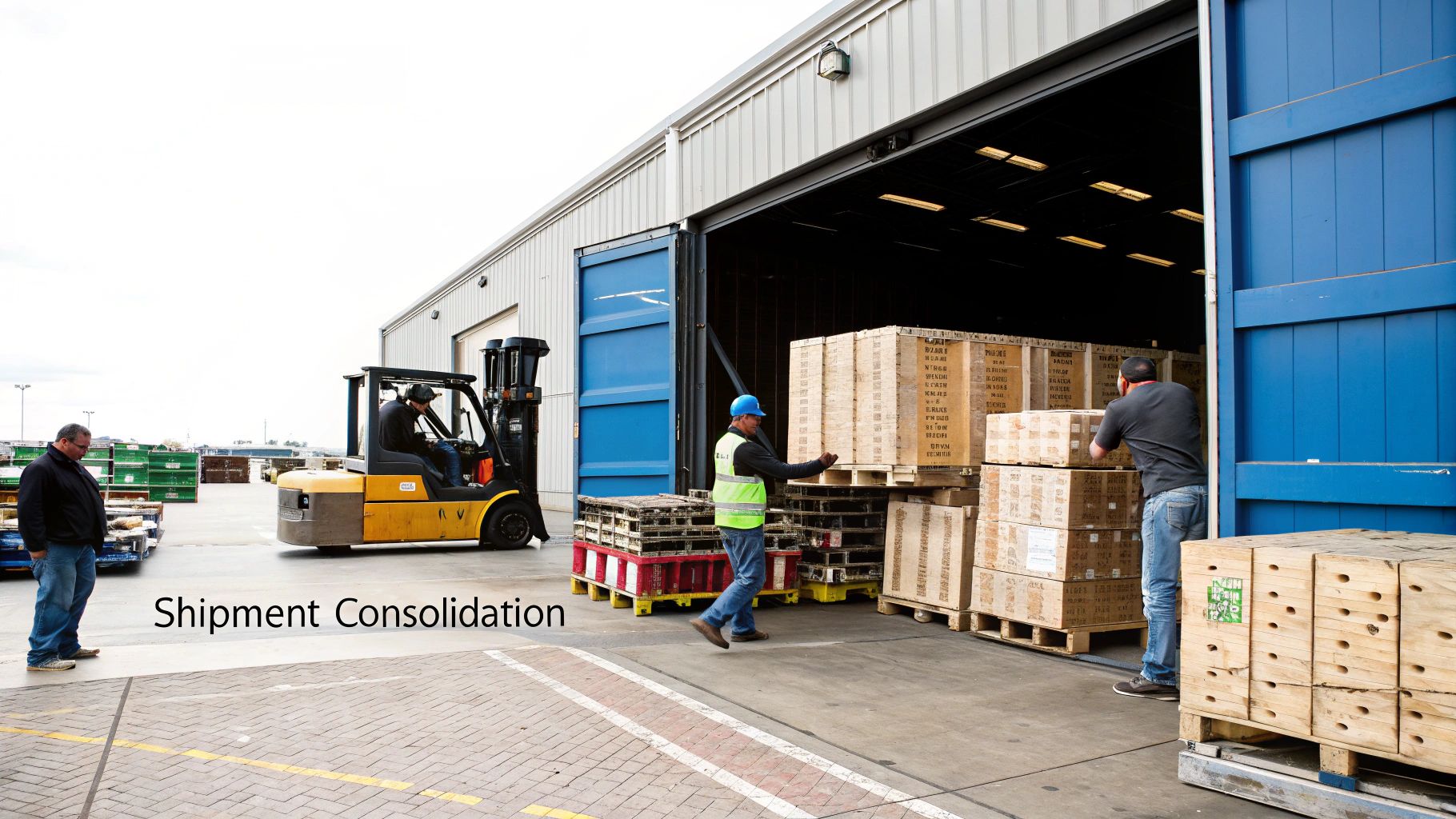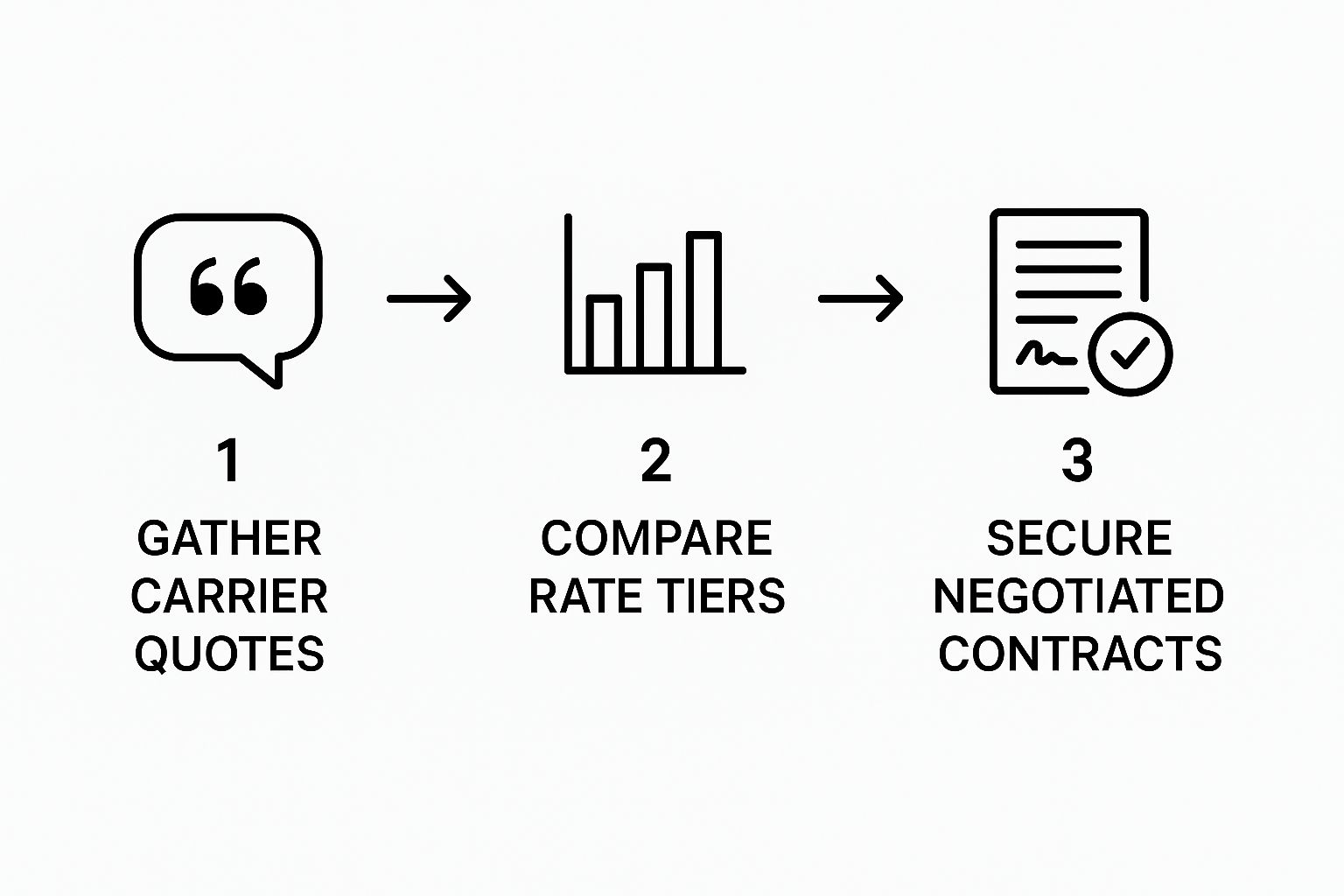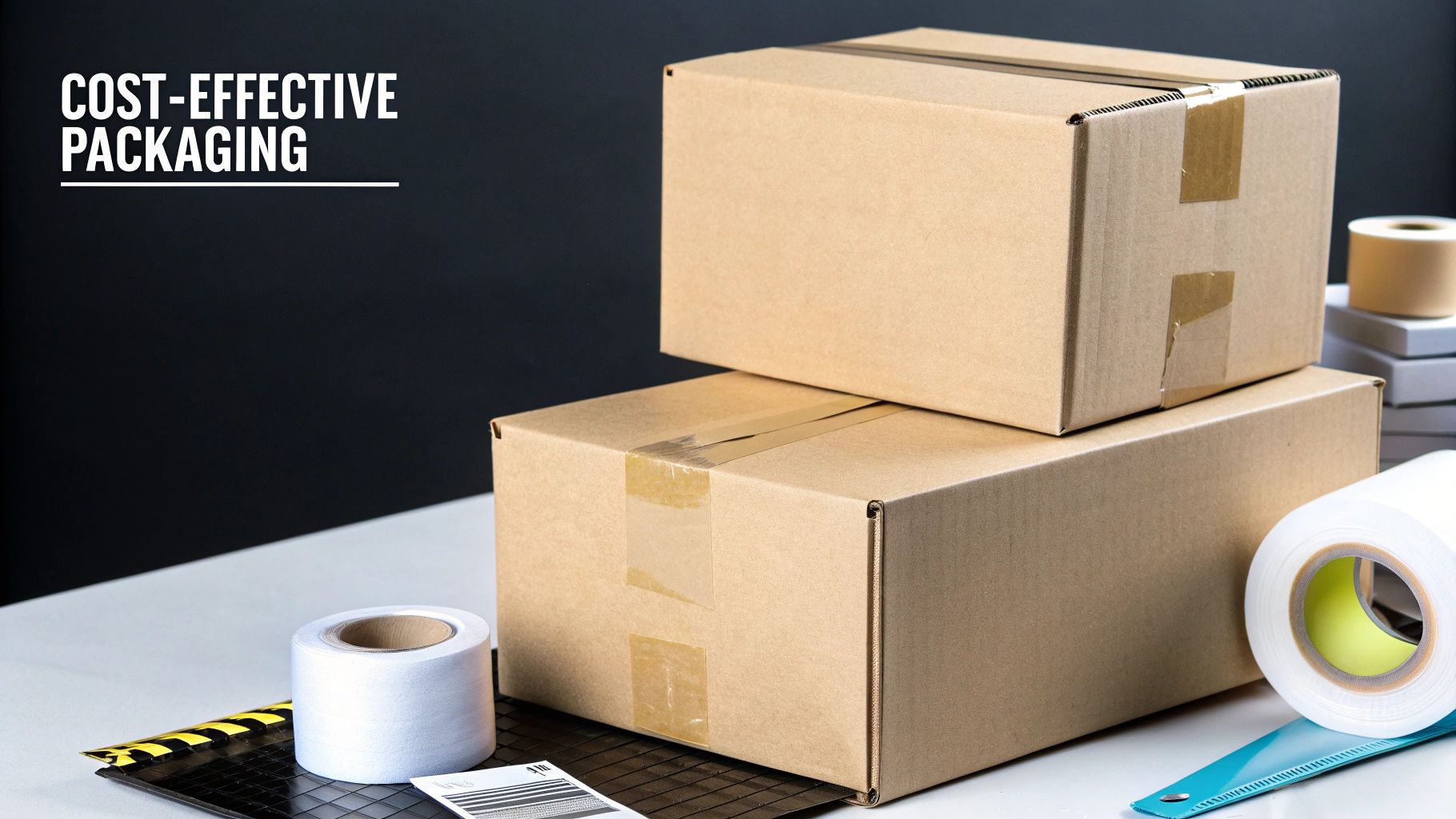Learn how to reduce freight costs with actionable strategies for negotiation, consolidation, and technology. Start saving on your shipments today.

Feeling the pressure of rising shipping costs? Let's be honest, who isn't? It’s a constant battle for anyone moving goods. The secret to winning isn't some magic bullet, but a smart, multi-layered approach. It’s about building stronger carrier relationships, getting smarter with your loads, and finally putting the right technology to work for you.
This guide is all about rolling up our sleeves and digging into the practical, real-world tactics that actually move the needle on your freight spend.

Finding ways to chip away at your shipping expenses is one of the most direct ways to protect your bottom line. But with so many moving parts, figuring out where to even begin can feel like trying to solve a puzzle in the dark.
Here's the good news: you have more influence over these costs than you probably realize. It's not about finding one massive saving. It’s about making a series of intentional, strategic adjustments across your entire shipping operation.
Key Takeaway: You can't just set and forget your freight strategy. A resilient, cost-effective shipping operation is built on actively managing three core pillars: your carrier relationships, your shipment efficiency, and your use of technology.
Before diving deep into these strategies, it helps to have a solid grasp of the fundamentals. If you're looking for a refresher on the basics, our guide on how to ship freight is a great place to get up to speed.
Let's face it, the market is tough right now. We're still seeing global freight rates that are roughly 140% higher than they were back in 2019. This isn't just a blip; it's the result of persistent supply chain headaches and a shaky global landscape.
With potential tariff hikes on the horizon, being proactive isn't just a good idea—it's essential for survival. To get ahead, smart shippers are getting creative with their logistics, diversifying transit routes, and rethinking their inventory strategies. It’s all about building flexibility into a rigid system.
To get started, let’s break down the main strategic areas where you can make a real impact on your freight expenses. Think of these as the foundation of your cost-reduction plan.
This table sums up the three foundational areas we'll be exploring. Each one represents a significant opportunity to cut costs and improve your overall logistics performance.
By focusing your efforts on these three pillars, you create a powerful, systematic approach to driving down expenses.
Ready to see how your current rates stack up against what you could be paying?

When it comes to freight, your relationship with a carrier is so much more than a simple transaction. It’s a genuine partnership, and nurturing it is one of the smartest ways to unlock real savings and boost service reliability.
A lot of shippers fall into the trap of just hunting for the lowest price on a single shipment. But a far better strategy for how to reduce freight costs is to build a solid, collaborative foundation that gives you long-term control.
Instead of constantly pitting carriers against each other in a race to the bottom, start thinking about what you bring to the table. When you understand their challenges and operational needs, you can negotiate from a place of mutual strength and become what we call a "shipper of choice."
This isn't just about getting a better price. It's about securing better service and more reliable capacity, which becomes absolutely priceless when the market gets tight.
At the end of the day, carriers want what any business wants: consistent, reliable, and easy work. When your freight is predictable and your operations run smoothly, you immediately become a more attractive client. This is your leverage, regardless of your shipping volume.
Try looking at your own operation from the carrier's point of view. Are their drivers stuck waiting hours at your dock? Is your paperwork always accurate? Making small improvements in these areas can completely change how they see your business.
Here are a few things you can do to strengthen that partnership:
A strong partnership is built on making the carrier's job easier. When you become a low-hassle, high-value client, carriers are far more willing to offer preferential pricing and dedicated capacity to keep your business.
This kind of strategic thinking is vital across all shipping modes, and ocean freight is no exception. In fact, adapting to market dynamics is one of the best ways to cut costs there. Shippers who proactively adjust their strategies can see cost reductions of up to 15% compared to those sticking with outdated methods. This comes from taking advantage of increased vessel capacity, finding better routes, and locking in rates with volume commitments. You can learn more about these trends in the 2025 ocean freight market.
Once you’ve established yourself as a shipper they want to work with, you can start moving beyond one-off spot quotes and into more stable, negotiated agreements. This is where the big savings are truly found.
Don't be afraid to negotiate, even if you're not a Fortune 500 company. Carriers are often happy to give discounts for consistent volume on specific lanes. If you regularly ship from Point A to Point B, talk to them about a dedicated rate for that route.
Consider structuring a simple pricing agreement or even a mini-bid. It doesn’t need to be a complex legal document. It can be as straightforward as an agreement outlining rates for your top 5-10 shipping lanes in exchange for a guaranteed amount of business.
This approach is a win-win. You get rate stability and predictable costs, and the carrier gets dependable freight that helps them build a more efficient network. It’s a powerful way to reduce freight costs for the long haul, not just on your next shipment.
Are you paying to ship air? It's a surprisingly common trap and a huge reason why freight bills spiral out of control. One of the most effective ways I've seen to reduce freight costs is to get really good at smart consolidation and mode optimization. This means you stop just booking the next truck out and start thinking strategically about how your freight is grouped and moved.
At its heart, consolidation is pretty simple: turn a bunch of small, pricey shipments into one bigger, more economical load. It’s all about making sure you use every square inch of the trailer space you're paying for. And this isn't some secret trick only the big guys can use—businesses of all sizes can slash their spending once they know what to look for.
Think about your Less-Than-Truckload (LTL) shipments. Each one is like its own little puzzle piece, with its own cost, its own Bill of Lading, and its own handling fees. When you ship them one by one, you’re paying a premium for that piecemeal approach.
But here’s where the opportunity lies. When you have several LTL shipments all headed to the same general area or along a similar route, you can combine them. You can build a single Full Truckload (FTL) shipment that makes multiple stops. I’ve seen it time and time again: the total cost of a multi-stop truckload is almost always far less than what you’d pay for all those LTLs separately.
Shipper Insight: I've found the magic number for consolidation usually sits between 10,000 to 15,000 pounds. If your pallets add up to that weight range and are moving in the same direction around the same time, it’s a huge red flag that you should be pricing it as an FTL.
For a deeper look into the nuts and bolts of LTL, our guide on navigating the complexities of LTL freight loads is a great resource for spotting these consolidation chances.
The real key is having visibility over your upcoming schedule. Take a look at your shipments for the next week or two. Are you sending three separate 4-pallet shipments from Chicago to the Dallas area on Monday, Wednesday, and Friday? That’s a perfect candidate to consolidate into a single FTL that leaves mid-week.
This chart really drives home how a simple, repeatable process is the foundation for finding better rates, whether you're consolidating or just negotiating a single load.

It shows that a methodical approach—gathering quotes, comparing your options, and locking in agreements—is absolutely fundamental to cutting your spend.
Consolidation is one half of the equation. The other half is mode optimization—a fancy term for simply picking the smartest, most cost-effective way to move your freight. Far too many shippers just default to an over-the-road (OTR) truck without even glancing at the other options on the table.
Here are the main players you should always be considering:
So how does intermodal work? A truck picks up the container at your dock, drives it to a railyard, and the train handles the long-haul portion. Then, another truck takes it for the final delivery. Simple.
Let's put some real numbers to it. Say you've got a full truckload that needs to get from Los Angeles to New York.
If your customer's delivery window can handle the extra transit time, you just pocketed $1,200 in savings—a 24% reduction on just one shipment. When you start analyzing your regular lanes and planning ahead, you can make intermodal a core part of your playbook to consistently reduce freight costs on those long-distance moves.

It’s one of those things that’s so easy to overlook, but the very box your product ships in is a silent, but significant, driver of your freight costs. Every extra inch of space, every unneeded ounce of cardboard or packing material—it all adds up. Multiply that by hundreds or thousands of shipments, and you're looking at a serious impact on your bottom line.
Here’s the good news: optimizing your packaging is one of the most direct and immediate ways to reduce your freight spend. Unlike tangled carrier negotiations, this is something you have complete control over, right now, in your own facility. By shrinking your shipment's footprint and weight, you're taking direct action to lower your expenses.
Ever wonder how much you could save on your next FTL or LTL shipment? It's probably more than you think.
First things first, you have to get familiar with a little concept called dimensional weight, or DIM weight. It’s the metric carriers use to charge you for the space your shipment takes up on their truck, not just what it weighs on a scale. They'll charge you based on whichever is greater: the actual weight or the DIM weight.
Think of it this way: carriers need to prevent shippers from sending a huge box of pillows for the same price as a small, dense box of steel bolts. The pillows might be light, but they eat up valuable real estate on the trailer. So, carriers use a formula (length x width x height) to calculate a theoretical weight for the space occupied.
Here’s the key takeaway: If your products are bulky but light, you are almost certainly paying based on DIM weight. Knocking even a single inch off your box dimensions can translate into a surprisingly significant drop in your shipping bill.
So, where do you find these savings? It starts with a simple "packaging audit." Just grab a tape measure, a scale, and a few of your most frequently shipped products. It’s time to get hands-on.
As you look at your packed boxes, ask yourself a few honest questions:
The materials you choose for your boxes and dunnage have a huge say in your final billable weight. A simple material swap can often lead to impressive savings without ever putting your product at risk.
For example, do you really need that heavy, double-walled corrugated box, or would a lighter-grade alternative work just as well for your product? The latest packaging materials often provide better protection at a fraction of the weight.
Here are a few smart swaps to consider:
By taking the time to audit your packaging, understand how DIM weight really works, and make smarter material choices, you can quite literally shrink your freight costs. It's a practical, hands-on strategy that puts you firmly in control.
In today's logistics world, guessing is just a recipe for overspending. If you're still relying on gut feelings and old spreadsheets, you’re almost certainly leaving money on the table. The most efficient shippers I know don't just work harder; they work smarter. Their secret weapon? Data. Technology is what turns all that raw information into real, actionable decisions that can genuinely reduce freight costs.
By embracing the right tools, you can swap out guesswork for a crystal-clear, real-time view of your entire shipping operation. It’s the difference between being reactive—scrambling to cover a last-minute load—and being proactive. You start getting ahead of problems and spotting savings opportunities before they’re gone.
Ready to see how technology can instantly find you competitive FTL and LTL rates?
At the heart of any modern shipping strategy is a Transportation Management System, or TMS. Think of it as your logistics command center. A solid TMS automates all the tedious, time-sucking tasks that tie up your team and gives you the visibility you need to make better calls.
Forget calling three different carriers for a quote. With a TMS, you can see real-time rates from dozens of your carriers on a single screen. This instant comparison ensures you’re not overpaying and helps you find that sweet spot between cost and service for every single shipment.
But a good TMS does more than just shop for rates. It helps you:
Partnering with a modern logistics provider or a freight broker is often the fastest way to get access to a powerful TMS. If you're curious about how these partners work, our guide on the definition of a freight broker explains how they use technology to help shippers just like you.
Beyond a TMS, your most powerful cost-saving tool is your own shipping history. The data you generate every single day is packed with clues that can make your operation leaner and more efficient. By digging into this information, you can spot expensive habits and trends you never even knew you had.
For instance, your data might show that one particular shipping lane is consistently costing you more than all the others. Armed with that specific insight, you can go to your carriers and negotiate a better rate for that route or start exploring other options, like intermodal.
Shipper Insight: I once worked with a client who, after analyzing their shipping data, realized they were paying a huge premium for shipping out on Mondays. By simply shifting their primary shipping day to Tuesday, they dodged the weekend capacity crunch and cut their weekly freight spend by nearly 8%. It was a simple change that came directly from the data.
This kind of analysis is absolutely critical, especially when outside forces cause rates to swing wildly. For example, ocean freight rates from Asia to the U.S. West Coast recently saw a massive plunge of nearly 60%, falling from around $6,000 to $2,390 per container. This dramatic shift was driven by policy changes and carriers adding capacity back into the market. Shippers who were actively tracking these trends were able to adjust their strategies on the fly and lock in massive savings. To see more on this, you can discover more insights about shipping rate fluctuations on Freightos.com.
Reducing your freight costs isn't about finding one secret trick. It's an ongoing process of making smart adjustments, planning ahead, and always looking for ways to improve. We've gone through the big-picture strategies that give you real control over your shipping budget—from building solid carrier relationships and optimizing every load to rethinking your packaging and using the right tech.
The biggest thing I want you to walk away with is this: you have way more power over these expenses than you might realize. You don't need to tear down your entire operation and rebuild it from scratch.
The road to real, lasting savings is built on a series of small, consistent wins. Just by putting one or two of these ideas into practice, you can start seeing a real difference in your bottom line and build a much stronger supply chain.
This whole journey starts with one simple, but absolutely critical, first step: figuring out where you are right now.
The best way to kick things off is to take a hard look at your current spending and find just one area to focus on. Is it your packaging? Maybe you're paying for air because your boxes are too big. Are you missing opportunities to bundle LTL shipments into a more affordable multi-stop full truckload? Or perhaps you've fallen into the habit of not shopping around for rates on every single load.
Just pick one. That's it.
For most businesses, benchmarking current rates is the perfect place to start. It instantly shows you if you're overpaying and shines a light on your first—and often easiest—chance to save some serious cash.
Curious what that first opportunity could look like for your business? You can get a real-time benchmark of your FTL or LTL rates in just a few minutes. It's the quickest way to get a clear picture of how to lower your freight costs and start building a more efficient operation today.
Even with a solid game plan, questions always pop up once you start digging into the details of lowering your shipping spend. Let's tackle some of the most common ones we hear from shippers who are ready to get smarter about their logistics.
If you're looking for quick wins in Less-Than-Truckload (LTL) shipping, zoom in on two areas: shipment density and consolidation.
First things first, look at your packaging. Make sure your products are packed as tightly and efficiently as possible. This is your best defense against dimensional weight (DIM) charges, which carriers use to bill you for light but bulky items that take up a lot of space. The less air you ship, the better.
Next, see if you can bundle smaller LTL shipments heading to the same general area. A good freight partner or a Transportation Management System (TMS) can help you spot these opportunities. Combining several small shipments into a single multi-stop truckload almost always slashes the cost per shipment. Since LTL rates are constantly in flux, getting fresh quotes for every single shipment is also a must to make sure you’re not leaving money on the table.
Honestly, the savings can be huge. We regularly see shippers cut their costs by 5% to 20%, sometimes even more, depending on their freight volume and how consistent their shipping lanes are. And it’s not just about the base rate.
You can also negotiate discounts on fuel surcharges, get certain accessorial fees (like for a liftgate or residential delivery) waived completely, or lock in better payment terms. The trick is to walk into that conversation armed with data. Know your freight volume, frequency, and top routes inside and out. The more predictable and appealing your business is for a carrier, the more leverage you’ll have at the negotiating table.
There's a time and place for both, and the right answer really depends on your business. If you have a massive, steady volume moving on just a handful of dedicated lanes, going direct can work out well.
For most businesses, though, a good freight broker or 3PL brings incredible value. They give you instant access to a massive network of pre-vetted carriers, which translates into serious buying power and a much better chance of finding a truck when capacity is tight. More importantly, they bring the expertise and technology to the table that helps you optimize everything—from choosing the right mode to consolidating shipments—unlocking savings you’d likely never find on your own.